Experimental Study on the Reinforcement Mechanism of Segmented Split Grouting in a Soft Filling Medium
Abstract
:1. Introduction
2. Three-Dimensional Grouting Simulation Test System
2.1. The Simulation Test Frame System
2.2. Grouting Module
3. The Experiment Design for Grouting
3.1. Test Target
- The thickness variation characteristics and the spatial distribution of the grouting veins along the direction of grout migration were obtained.
- The mechanical parameters and permeability coefficient of the injected media before and after grouting were tested, and the quantitative relationship between the mechanical properties and permeability coefficient of the soft filling medium before and after the grouting was established.
3.2. Segmented Split Grouting Process
3.3. Design of Filling Scheme
3.4. Selection of Grouting Parameters
3.4.1. Selection of Grouting Pressure
3.4.2. Selection of Grouting Material
3.4.3. Design of Slurry Color
4. Experiment Result Analysis
4.1. Distribution Characteristics and Thickness Analysis of Grouting Vein
4.1.1. Skeleton Vein
4.1.2. Cross-Grid Grouting Vein
4.1.3. Parallel Dispersed Grouting Vein
4.2. Analysis of Grouting Reinforcement Effect
4.2.1. Compression Strength
4.2.2. Anti-Permeability
5. Conclusions
- (1)
- A three-dimensional grouting simulation test system was developed, which could realize the subsection split grouting in a soft filling medium. Moreover, it could be used to conduct the excavation observation and sampling analysis after grouting.
- (2)
- There was no permeable grouting in the soft filling medium with poor permeability, but the form of grouting in this medium was mainly split grouting. Three types of veins were formed when the soft filling medium was consolidated by subsection split grouting; namely, skeleton support veins, cross-grid pulp veins, and parallel dispersed pulp veins. The thicknesses of the grouting veins decreased gradually as the distance from the grouting holes increased, and the strikes of grouting veins exhibited increased randomness.
- (3)
- The special grouting reinforcement mechanism under the section split grouting was determined, and it consisted mainly of the reinforcement mode of the grout vein skeleton support, permeation-filling, and compaction-consolidation.
- (4)
- The elastic modulus of the grouting reinforcement solid increased on average by a factor greater than 100, and the permeability coefficient decreased on average by a factor greater than 40 in the direction of the parallel grouting vein with the most impermeable solid. This confirmed that segmental split grouting is an effective method for the improvement of the mechanical properties and the impermeability of the weak filling media.
Author Contributions
Funding
Conflicts of Interest
References
- Marchi, M.; Gottardi, G.; Soga, A.K. Fracturing Pressure in Clay. J. Geotech. Geoenviron. Eng. 2014, 140, 04013008. [Google Scholar] [CrossRef]
- Bezuijen, A.; te Grotenhuis, R.; van Tol, A.F.; Bosch, J.W.; Haasnoot, J.K. Analytical Model for Fracture Grouting in Sand. J. Geotech. Geoenviron. Eng. 2011, 137, 611–620. [Google Scholar] [CrossRef]
- Hernqvist, L.; Gustafson, G.; Fransson, Å.; Norberg, T. A statistical grouting decision method based on water pressure tests for the tunnel construction stage—A case study. Tunn. Undergr. Space Technol. 2013, 33, 54–62. [Google Scholar]
- Tan, Y.H. Evolutionary Mechanism of Mud Bursting through Water-Inrich Fault in Tunnels and Engineering Applications. Ph.D. Thesis, Shan Dong University, Jinan, China, 2017. (In Chinese). [Google Scholar]
- Yu, W.S. Grouting Diffusion Mechanism in Mud Filled Fault Fracture Zone of Tunnel and It’s Engineering Application. Ph.D. Thesis, Changsha University of Science & Technology, Changsha, China, 2017. (In Chinese). [Google Scholar]
- Wang, Z.C.; Li, F.Q. Slurry water curtain grouting and its mechanism in complex coal mine area. J. Cent. South Univ. (Sci. Technol.) 2013, 44, 778–784. (In Chinese) [Google Scholar]
- Zhou, K.F.; Li, Y.Z. Influence of grouting on the mechanical characteristic of stratified rock slope. J. Cent. South Univ. (Sci. Technol.) 2012, 43, 724–729. (In Chinese) [Google Scholar]
- Zhang, M.; Zou, J.; Chen, J.; Li, X.; Li, Z. Analysis of soil fracturing grouting pressure under asymmetric loads. Rock Soil Mech. 2013, 34, 2255–2263. (In Chinese) [Google Scholar]
- Li, S.C.; Zhang, W.J.; Zhang, Q.; Zhang, X.; Liu, R.; Pan, G.; Li, Z.; Chen, Z. Research on advantage-fracture grouting mechanism and controlled grouting method in water-rich fault zone. Rock Soil Mech. 2014, 3, 745–751. (In Chinese) [Google Scholar]
- Sun, F.; Chen, T.; Zhang, D.; Zhang, Z.; Li, P. Study on fracture grouting mechanism in subsea tunnel based on Bingham fluids. J. Beijing Jiaotong Univ. 2009, 33, 1–6. (In Chinese) [Google Scholar]
- Zhang, Z.; Zou, J. Penetration radius and grouting pressure in fracture grouting. Chin. J. Geotech. Eng. 2008, 30, 181–184. (In Chinese) [Google Scholar]
- Sun, F.; Zhang, D.; Chen, T. Fracture grouting mechanism in tunnels based on time-dependent behaviors of grout. Chin. J. Geotech. Eng. 2011, 33, 88–93. (In Chinese) [Google Scholar]
- Zhang, Q.; Zhang, L.; Liu, R.; Yu, W.; Zheng, Z.; Wang, H.; Zhu, G. Split grouting theory based on slurry-soil coupling effects. Chin. J. Geotech. Eng. 2016, 38, 323–330. (In Chinese) [Google Scholar]
- Zhang, L. Study on Penetration and Reinforcement Mechanism of Grouting in Sand Layer Disclosed by Subway Tunnel and Its Application. Ph.D. Thesis, Shandong University, Jinan, China, 2017. (In Chinese). [Google Scholar]
- Li, P.; Zhang, X.; Zhang, Q. Analysis on three-dimensional diffusion mechanism of multi-sequence grouting in fault. Geotech. Spec. Publ. 2016, 2016, 121–129. (In Chinese) [Google Scholar]
- Li, P.; Zhang, Q.; Zhang, X. Grouting diffusion characteristics in faults considering the interaction of multi-sequence grouting. Int. J. Geomech. 2016, 17, 04014117. (In Chinese) [Google Scholar]
- Zhang, B.W. Experimental Study on Compaction Grouting and Fracture Grouting of Soft Clay in the High-Speed Rail Way Foundation. Ph.D. Thesis, Southwest Jiaotong University, Chengdu, China, 2013. (In Chinese). [Google Scholar]
- Zheng, C.C. Estimation on Penetrating Radius of Stable Cement Grouts in Rock Fractures. J. Water Resour. Arch. Eng. 2006, 4, 1–5. (In Chinese) [Google Scholar]
- Li, P.; Zhang, Q.S.; Zhang, X.; Li, S.; Zhang, W.; Li, M.; Wang, Q. Analysis of fracture grouting mechanism based on model test. Chin. J. Rock Mech. Eng. 2014, 35, 3221–3230. (In Chinese) [Google Scholar]
- Darling, W.G.; Bath, A.H.A. Stable isotope study of recharge processes in the English Chalk. J. Hydrol. 1988, 101, 31–46. [Google Scholar] [CrossRef]
- Li, Z. Mechanism of Grouting Spread and Reinforcement on Soft Medium in Fault and Its Application. Ph.D. Thesis, Shan Dong University, Jinan, China, 2015. (In Chinese). [Google Scholar]
- Liu, R.; Li, S.; Zhang, Q.; Yuan, X.; Han, W. Experiment and application research on a new type of dynamic water grouting material. Chin. J. Rock Mech. Eng. 2011, 30, 1454–1459. (In Chinese) [Google Scholar]
- Sha, F.; Liu, R.; Li, S.; Lin, C.; Li, Z.; Liu, B.; Bai, J. Application on different types of cementitious grouts for water-leakage operational tunnels. J. Cent. South Univ. (Sci. Technol.) 2016, 47, 4163–4172. (In Chinese) [Google Scholar]
- Xu, Z.L. Elasticity; Higher Education Press: Beijing, China, 2013. (In Chinese) [Google Scholar]
- Liu, J.J.; Zhang, B.H. Fluid Mechanic; Peking University Press: Beijing, China, 2016. (In Chinese) [Google Scholar]
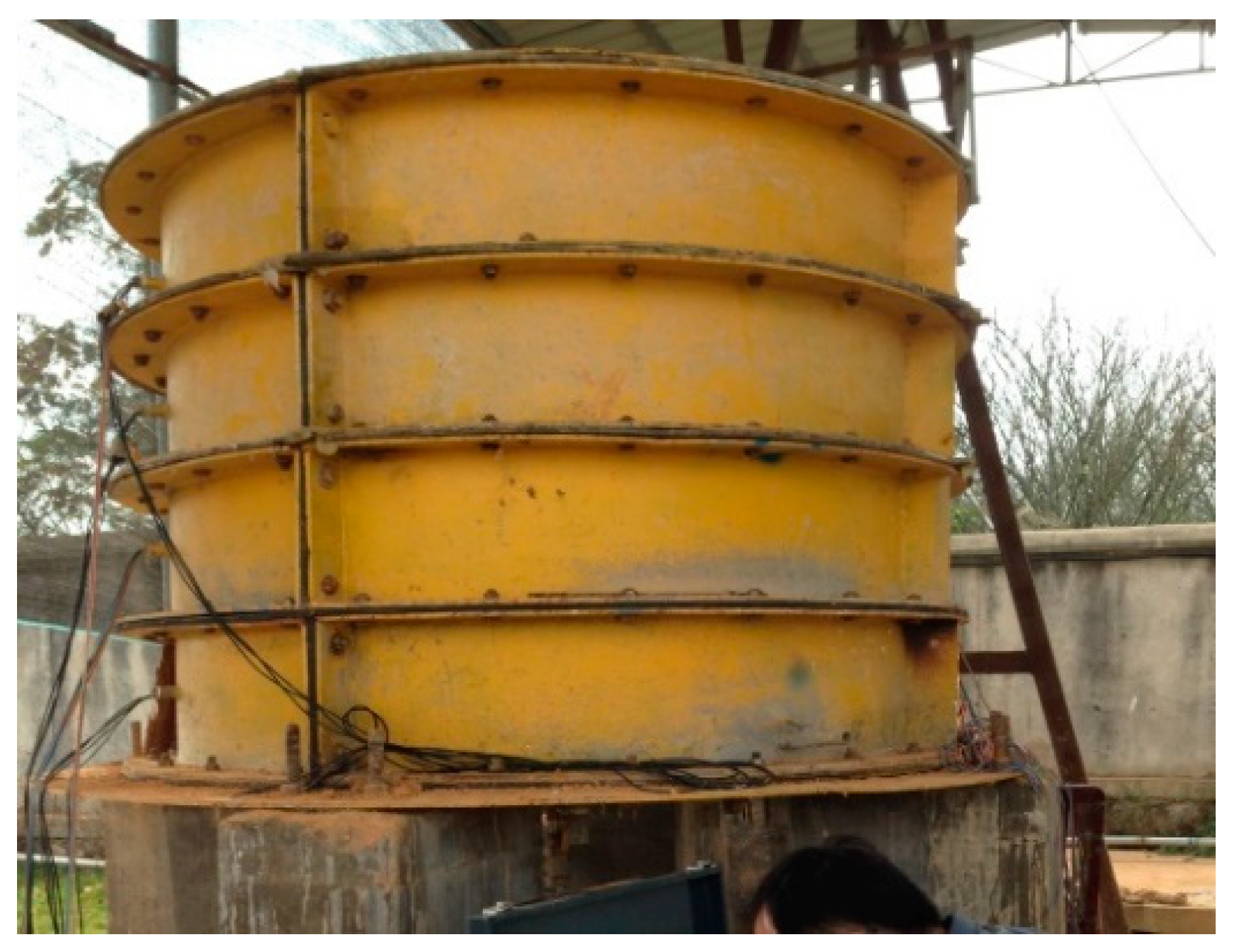

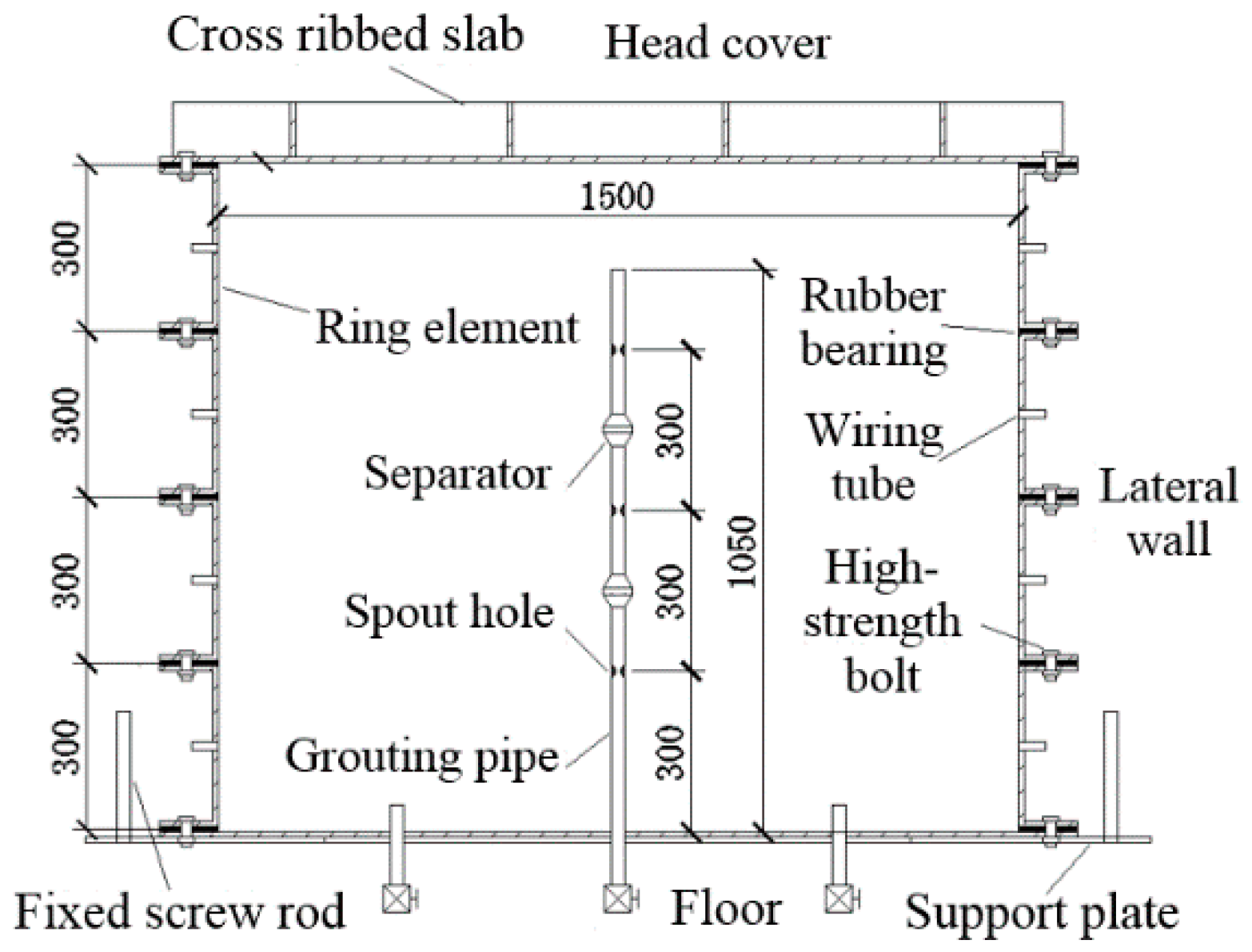
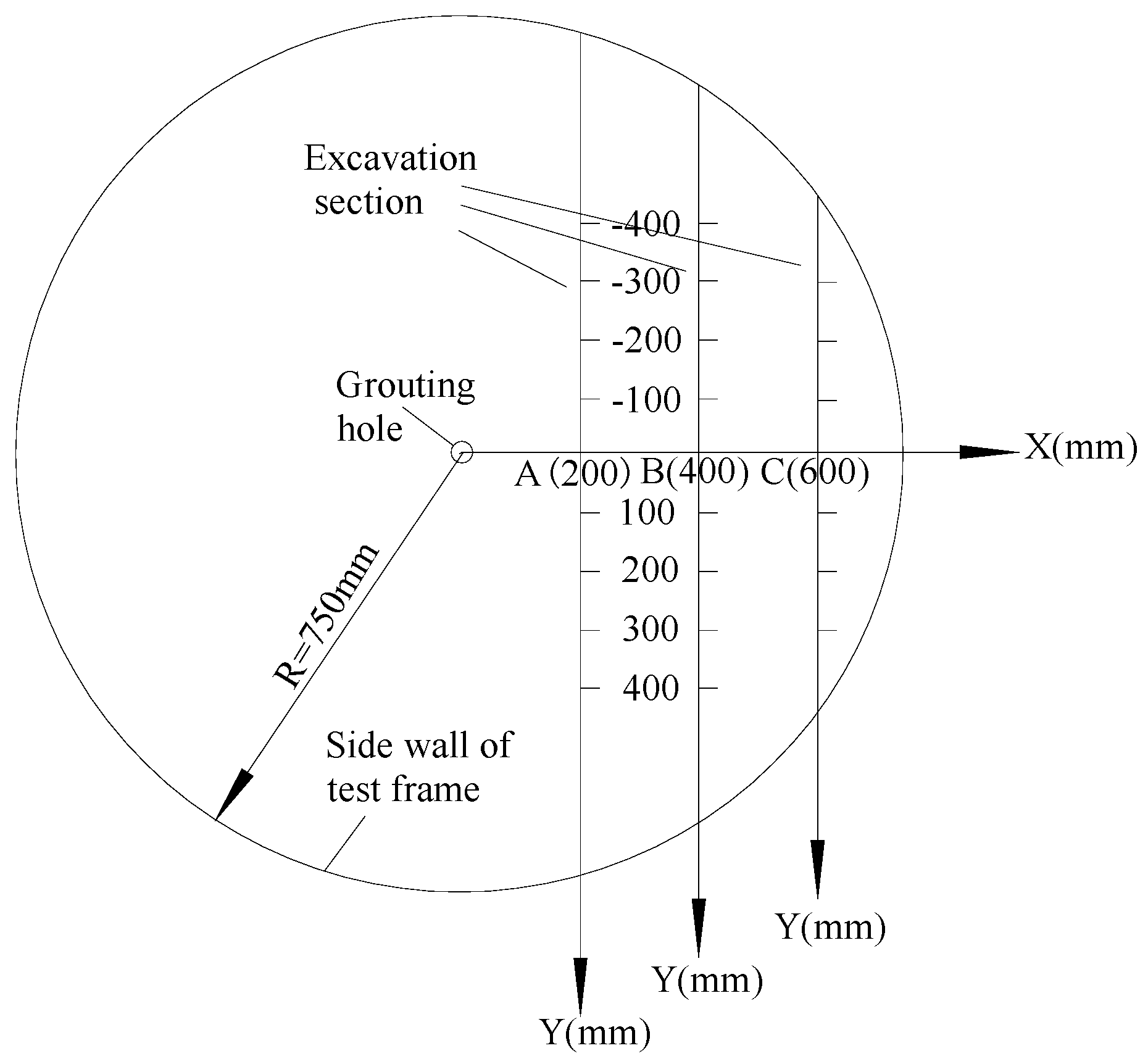
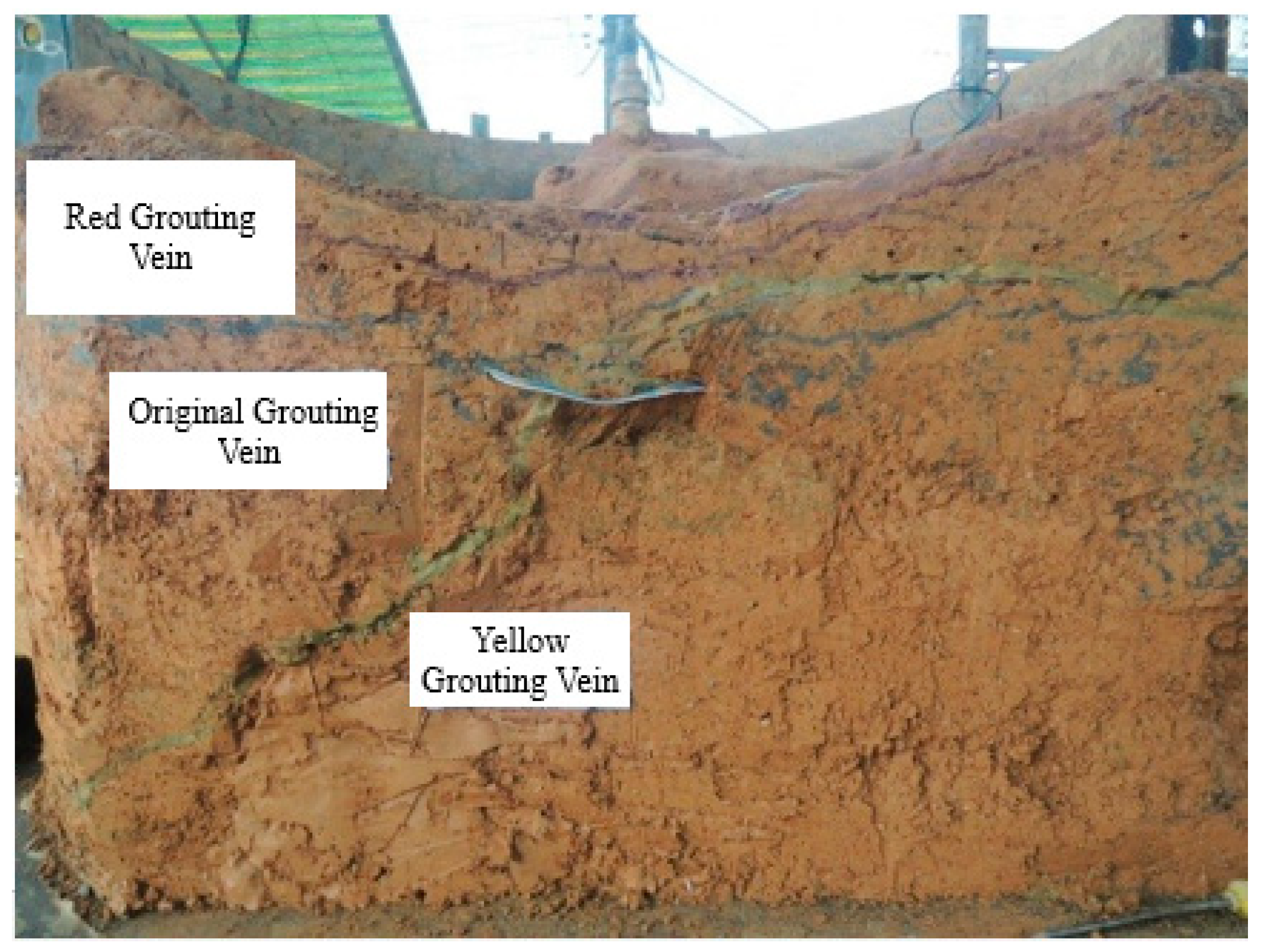




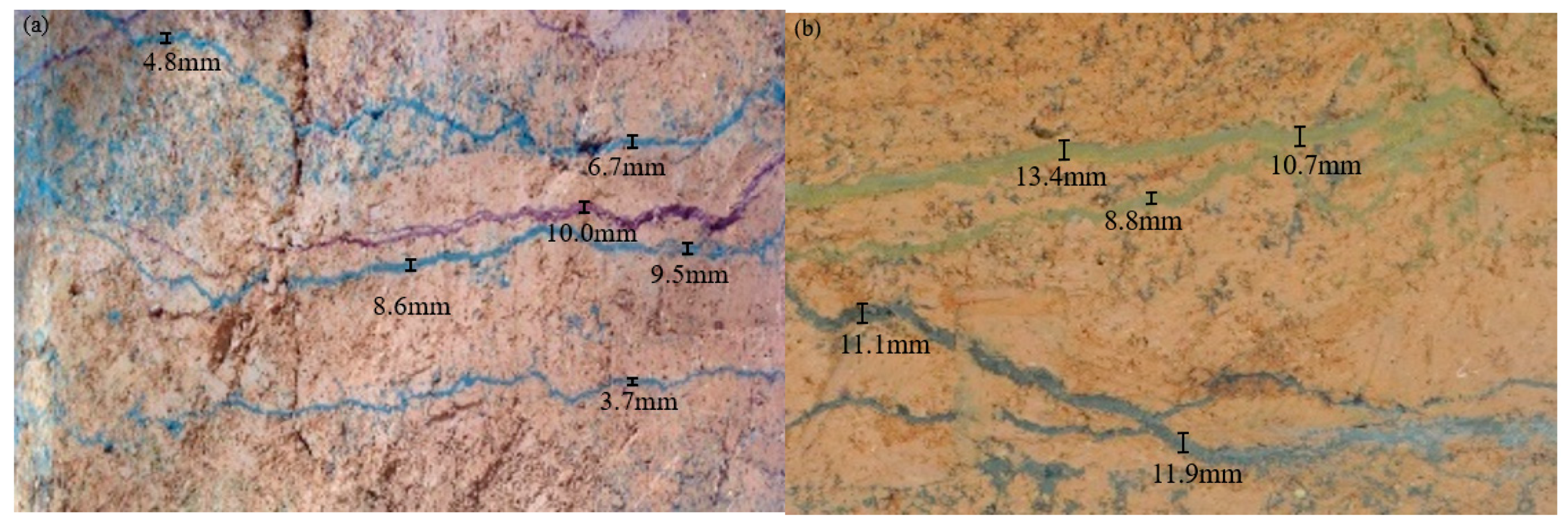



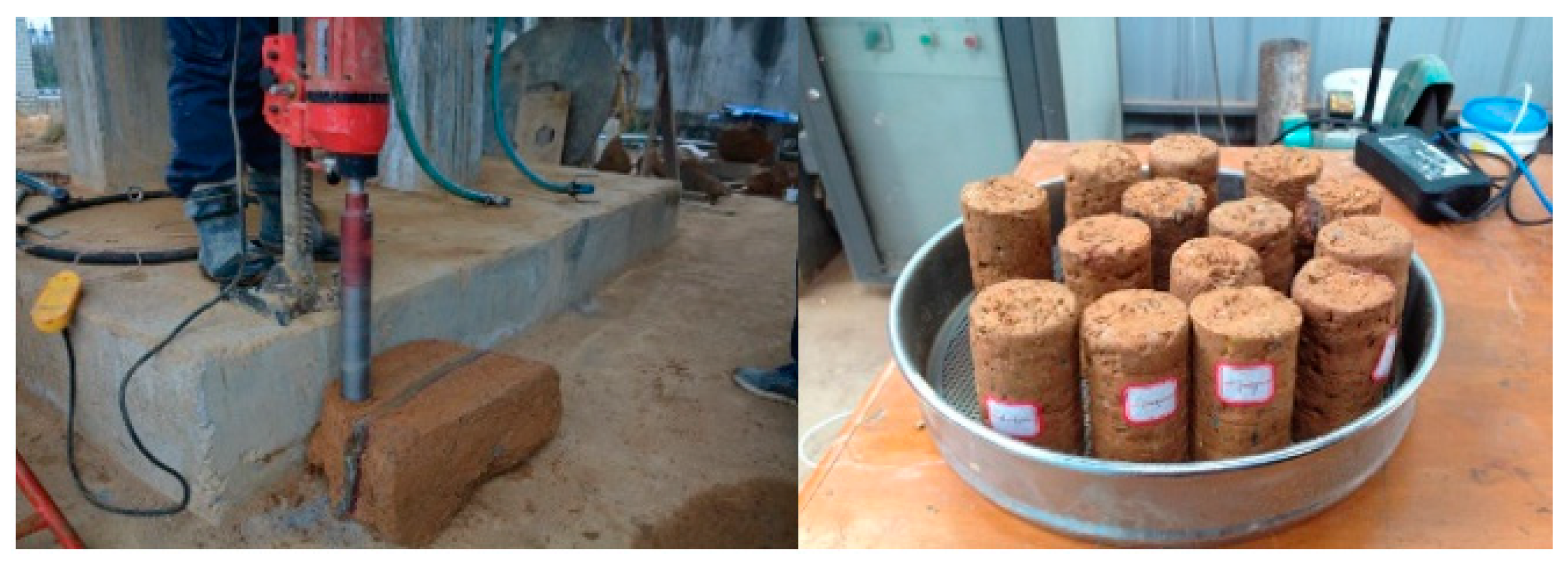



| Initial Water Content | Dry Density | Permeability Coefficient | Liquid Limit | Fine Cement | Porosity | |
|---|---|---|---|---|---|---|
| Material type | ω (%) | ρd (g·cm−1) | k (cm·s−1) | WI (%) | M (%) | P (%) |
| Soft clay | 37.8 | 1.17 | 5.2 × 10−4 | 45.9 | 36.7 | 31.5 |
| W/C | VC:VGT | Stone Rate (%) | Gel Time (s) | Age Strength (MPa) | ||||||
|---|---|---|---|---|---|---|---|---|---|---|
| Initial Setting Time | Final Setting Time | 1 h | 5 h | 1 Day | 3 Days | 14 Days | 28 Days | |||
| 1:1 | 1:1 | 85 | 45 | 80 | 0.5 | 1.8 | 3.0 | 7.0 | 8.0 | 8.9 |
| Serial Number | Order | Design Grouting Rate | Design Grouting Pressure (MPa) | Slurry Color | Bottom Height of Overflow Hole (cm) |
|---|---|---|---|---|---|
| 1 | First | 0–5 L/min | 1 | original | 30 |
| 2 | Second | 0–5 L/min | 1 | yellow | 60 |
| 3 | Third | 0–5 L/min | 1 | red | 90 |
| Elastic Modulus(E)/MPa and Standard Deviations(S) | ||||||||||||
|---|---|---|---|---|---|---|---|---|---|---|---|---|
| Location of Sample Cross-Section (cm) | Compacting Zone 1 | Splitting Zone 2 | Splitting Zone 4 | Splitting Zone 6 | Splitting Zone 8 | Compacting Zone 9 | ||||||
| E | S | E | S | E | S | E | S | E | S | E | S | |
| x = 0 | 96 | 1.56 | 182 | 1.45 | 284 | 2.23 | 235 | 2.21 | 168 | 1.10 | 94 | 3.21 |
| 124 | 1.36 | 205 | 2.11 | 296 | 3.12 | 312 | 5.36 | 212 | 3.65 | 126 | 2.10 | |
| 178 | 1.23 | 285 | 4.21 | 340 | 4.96 | 325 | 4.25 | 271 | 4.23 | 182 | 0.86 | |
| 152 | 2.65 | 247 | 3.95 | 388 | 6.02 | 363 | 6.21 | 243 | 5.21 | 148 | 0.79 | |
| 110 | 3.21 | 226 | 4.23 | 312 | 2.70 | 318 | 3.65 | 184 | 1.89 | 120 | 1.89 | |
| 85 | 2.21 | 196 | 1.87 | 275 | 1.14 | 304 | 1.58 | 150 | 5.11 | 87 | 2.36 | |
| x = 20 | 80 | 1.26 | 127 | 4.56 | 226 | 3.21 | 185 | 3.65 | 106 | 2.68 | 82 | 0.68 |
| 104 | 1.03 | 196 | 2.36 | 288 | 4.05 | 302 | 5.65 | 172 | 2.13 | 94 | 1.65 | |
| 148 | 2.01 | 264 | 3.29 | 307 | 3.04 | 325 | 4.96 | 203 | 0.98 | 138 | 2.31 | |
| 94 | 0.98 | 225 | 1.95 | 334 | 5.69 | 296 | 3.68 | 245 | 3.69 | 124 | 1.15 | |
| 87 | 1.68 | 158 | 0.98 | 272 | 4.12 | 252 | 1.56 | 164 | 5.45 | 91 | 2.35 | |
| 74 | 0.45 | 135 | 1.14 | 215 | 3.14 | 201 | 1.02 | 124 | 2.12 | 80 | 1.89 | |
| x = 40 | 65 | 0.65 | 105 | 1.68 | 202 | 4.56 | 196 | 3.68 | 94 | 1.56 | 52 | 1.22 |
| 92 | 1.56 | 150 | 1.89 | 243 | 3.68 | 230 | 2.65 | 144 | 1.68 | 68 | 2.36 | |
| 106 | 1.89 | 226 | 2.68 | 271 | 2.68 | 264 | 2.31 | 191 | 3.21 | 93 | 1.10 | |
| 85 | 0.96 | 210 | 3.87 | 238 | 1.59 | 256 | 1.58 | 244 | 2.68 | 102 | 0.65 | |
| 72 | 1.45 | 154 | 1.56 | 222 | 3.68 | 228 | 2.10 | 141 | 1.36 | 74 | 0.98 | |
| 54 | 1.54 | 96 | 1.68 | 195 | 4.65 | 184 | 1.22 | 116 | 1.26 | 65 | 0.48 | |
| x = 60 | 45 | 0.98 | 67 | 0.98 | 93 | 0.65 | 97 | 0.98 | 54 | 0.79 | 52 | 2.56 |
| 57 | 1.32 | 75 | 1.35 | 114 | 1.56 | 110 | 1.65 | 67 | 0.86 | 66 | 5.65 | |
| 93 | 1.89 | 101 | 1.68 | 146 | 1.75 | 158 | 2.65 | 96 | 1.12 | 80 | 2.65 | |
| 86 | 1.68 | 93 | 2.68 | 134 | 2.31 | 146 | 2.31 | 114 | 2.01 | 64 | 3.57 | |
| 78 | 2.12 | 78 | 0.98 | 102 | 1.62 | 112 | 1.12 | 84 | 1.10 | 48 | 2.32 | |
| 64 | 0.97 | 66 | 1.10 | 88 | 1.59 | 103 | 2.02 | 65 | 0.88 | 35 | 0.68 | |
| Location of Sample Cross-Section (cm) | Permeability Coefficient (10−6 cm/s) | |||||
|---|---|---|---|---|---|---|
| Compacting Zone | Splitting Zone | |||||
| 1 | 9 | 2 | 4 | 6 | 8 | |
| x = 0 | 8.6 | 27.4 | 0.7 | 0.2 | 0.4 | 1.7 |
| 16.3 | 32.6 | 1.6 | 0.4 | 0.6 | 2.2 | |
| 10.7 | 44.8 | 2.2 | 0.6 | 0.8 | 3.4 | |
| x = 20 | 22.5 | 38.5 | 1.2 | 0.4 | 0.8 | 3.4 |
| 27.4 | 45.4 | 2.3 | 0.4 | 0.6 | 4.4 | |
| 38.6 | 56.8 | 3.3 | 0.8 | 1.0 | 5.8 | |
| x = 40 | 48.1 | 67.4 | 4.6 | 0.7 | 0.7 | 5.7 |
| 52.7 | 71.5 | 5.2 | 0.8 | 0.8 | 6.3 | |
| 64.2 | 82.8 | 6.7 | 0.9 | 1.2 | 7.8 | |
| x = 60 | 68.8 | 78.5 | 5.5 | 0.9 | 1.3 | 7.3 |
| 74.5 | 86.2 | 6.6 | 1.12 | 1.4 | 7.9 | |
| 82.4 | 95.6 | 7.8 | 1.4 | 1.8 | 9.1 | |
© 2018 by the authors. Licensee MDPI, Basel, Switzerland. This article is an open access article distributed under the terms and conditions of the Creative Commons Attribution (CC BY) license (http://creativecommons.org/licenses/by/4.0/).
Share and Cite
Li, Z.; Li, S.; Liu, H.; Zhang, Q.; Liu, Y. Experimental Study on the Reinforcement Mechanism of Segmented Split Grouting in a Soft Filling Medium. Processes 2018, 6, 131. https://doi.org/10.3390/pr6080131
Li Z, Li S, Liu H, Zhang Q, Liu Y. Experimental Study on the Reinforcement Mechanism of Segmented Split Grouting in a Soft Filling Medium. Processes. 2018; 6(8):131. https://doi.org/10.3390/pr6080131
Chicago/Turabian StyleLi, Zhipeng, Shucai Li, Haojie Liu, Qingsong Zhang, and Yanan Liu. 2018. "Experimental Study on the Reinforcement Mechanism of Segmented Split Grouting in a Soft Filling Medium" Processes 6, no. 8: 131. https://doi.org/10.3390/pr6080131




